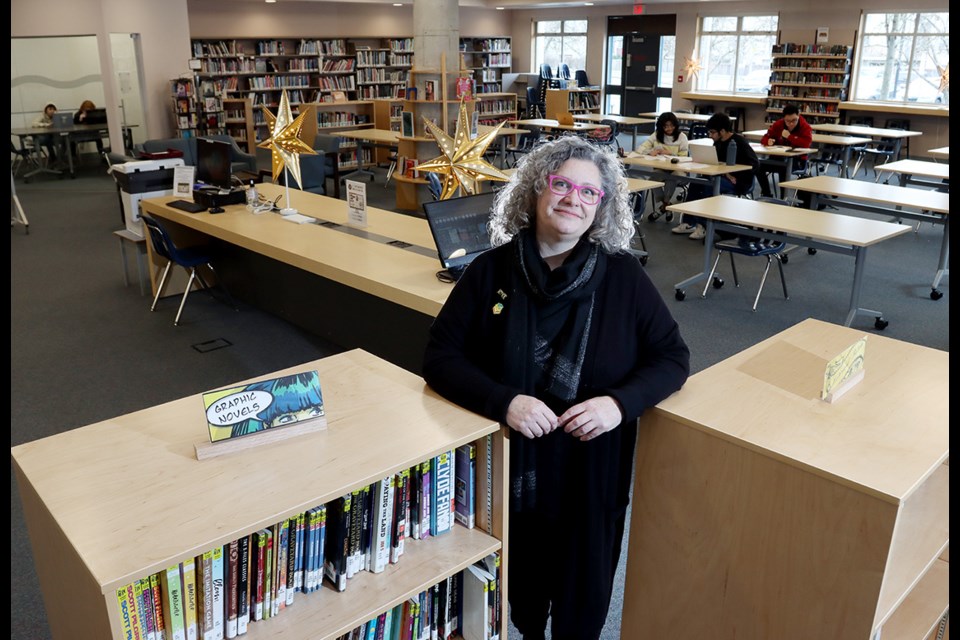A memo to those of you who used to sleep during library class — things have changed.
There's no more pretending to pour over giant reference books — in fact, you won't find one of those heavy tomes in a school library today.
Resources are all online as most paperback and hardcover books are for enjoyment only and students aren't expected to be quiet, any more.
There's an audible hum at the Riverside Secondary library in Port Coquitlam as students are busy working together on projects.
Some are making things with 3D printers or creating their own podcasts and videos while still others are staring into laptops or talking together about their projects.
The smell of a glue gun is strong as a Grade 10 student works on a project for science class; two girls in the green room are doing voice-overs for a video about their favourite francophone person.
A half-completed jigsaw puzzle sits on a desk waiting for someone to add to it; there's also food, left over waffles and fruit on a side table.
The old computer lab is empty of those clunky desk-tops and is awaiting sleek laptops while students' own cell phones are more powerful than any computer their parents' would have used back in the day.
Libraries now 'learning commons'
It's been a few years since the Tri-City News visited Riverside Secondary's library, and since then, the digital revolution has transformed the space.
Instead of a tightly-packed room full of books, gated by a circulation desk, the large room has been transformed into an open, airy space with movable desks and chairs.
There's a drop-down screen for presentations and glassed-in rooms for collaborating on projects.
What's happened is the traditional school library has been replaced by learning commons at all elementary and middle schools in School District 43 (SD43).
High schools, which require more digital tools and construction, are in transition, and two will be getting $50,000 grants to become learning commons, according to Stephen Whiffin, SD43's director of technology and instruction.
Riverside Secondary is a model for the learning commons, in a process that started five years ago with school-wide consultation.
A learning commons is a place where students use technology, online reference books and databases to collaborate, do projects, be creative and solve problems.
"It's a hub of resources, a hub of shared learning resources," according to teacher-librarian Susan Henderson, who said Microsoft's experimental Garage was an inspiration, as was Hootsuite and other tech centres.
Technology infused into classroom teaching
Many students are as adept at technology or more skilled than some teachers and offer tech support and trouble-shoot problems at the Wave corner.
Students are learning how to use "technology for good" at Riverside, and the learning commons provides them with resources to do just that, explained Henderson.
The idea is to make technology accessible to all and so students attend a boot camp when they enter the school in Grade 9, while their teachers provide them with support and technology to carry out their projects.
Podcasts, for example are "a hugely popular way for students to express their learning," said Whiffin.
Still, traditional books are important, say Henderson and Whiffin. While the school culled all its reference books six years ago, sending them oversees if they were useful and shredding them if they weren't, there are still 10,000 books at the school.
Students still love to read actual books
In fact, the district uses a mathematical "collection optimization standard" — 10 books per student at the high school level 15 at middle school and 20 at elementary school.
While the multi-volume Encyclopedia Britannica was dumped long ago in favour of resources such as Gale Engage or CBC's Curio, elementary students still use books as they are not yet part of the district's one-to-one laptop program, which starts in Grade 6.
"We encourage them [elementary students] to read non-fiction books," said Whiffin, adding it's "not about diminishing the role of books and literature, but it's recognizing that learning resources are much more dynamic."
In fact, books that are available tend to be those that students ask for, said Henderson. "It's something they want to read."
Back in the 'maker-space' room where robotics equipment sits in drawers near a soldering iron, students wander in looking for equipment.
Instead of learning from traditional reference books, the students are figuring out for themselves how to make something and the library commons at Riverside has what they need.
"It's about trying to get kids to imagine something in their head and make it in some concrete way," Whiffin said.





